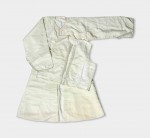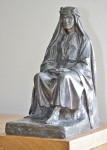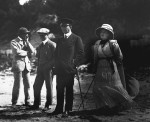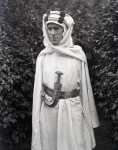 A magnificent presentation dagger and set of silk robes that belonged to T.E. Lawrence, also known as Lawrence of Arabia, have been placed under a temporary export bar by UK Culture Minister Ed Vaizey. The silver-gilt dagger was a gift from Sherif Nasir, cousin of Emir Faisal, given to T.E. Lawrence in 1917 after the victory of Arab Revolt at the Battle of Aqaba in Jordan. There’s a fictionalized version of the capture of Aqaba and the presentation the dagger in David Lean’s epic film Lawrence of Arabia.
A magnificent presentation dagger and set of silk robes that belonged to T.E. Lawrence, also known as Lawrence of Arabia, have been placed under a temporary export bar by UK Culture Minister Ed Vaizey. The silver-gilt dagger was a gift from Sherif Nasir, cousin of Emir Faisal, given to T.E. Lawrence in 1917 after the victory of Arab Revolt at the Battle of Aqaba in Jordan. There’s a fictionalized version of the capture of Aqaba and the presentation the dagger in David Lean’s epic film Lawrence of Arabia.
 The robes are a champagne silk zebun with a matching waistcoat meant to be worn under the full-length abayeh. The zebun is lined with white cotton and has cotton ties at the waist. The vest has a delicately embroidered brocade button trims. They were made in Mecca or Medina before 1919. Lawrence is depicted wearing the robes in a 1919 oil on canvas portrait by Augustus John.
The robes are a champagne silk zebun with a matching waistcoat meant to be worn under the full-length abayeh. The zebun is lined with white cotton and has cotton ties at the waist. The vest has a delicately embroidered brocade button trims. They were made in Mecca or Medina before 1919. Lawrence is depicted wearing the robes in a 1919 oil on canvas portrait by Augustus John.
 He wore both the garments and the dagger when he posed for Lady Kathleen Scott, sculptor and widow of Antarctic explorer Captain Robert Falcon Scott, for a statuette she entitled Blonde Bedouin. Lawrence was a national hero after World War I, a dashing figure who sat for many artists. Lady Scott was the first and last woman among them. She noted in her diary that she wrote asking him to pose for her and he replied on February 2nd, 1921, that he’d be glad to even though he’d been subject to the scrutiny of so many artists he wasn’t sure there was anything left for her to capture.
He wore both the garments and the dagger when he posed for Lady Kathleen Scott, sculptor and widow of Antarctic explorer Captain Robert Falcon Scott, for a statuette she entitled Blonde Bedouin. Lawrence was a national hero after World War I, a dashing figure who sat for many artists. Lady Scott was the first and last woman among them. She noted in her diary that she wrote asking him to pose for her and he replied on February 2nd, 1921, that he’d be glad to even though he’d been subject to the scrutiny of so many artists he wasn’t sure there was anything left for her to capture.
“Seriously if you want an object, I’ll agree with pleasure: only it won’t be a good speculation: it won’t sell afterwards: and my face isn’t so-to-speak virgin. […] [R]eally the features are quite worn away with so much study of them.
If you do do it, please hold me as a model, and not as ‘the most romantic figure of the war’ (American film-artist). I’m tired of the lime light, and am really not stagy at all, and not ever going to be a public figure again. It was a war effort, imposed, involuntary. Don’t do me as Colonel Lawrence (he died Nov. 11. 1918) but because my shaped head suits your whim.”
 A week later, Lawrence was posing in his Arabic clothing in Lady Scott’s drawing room. He sat for her a total of three times, which was enough to utterly charm the artist. She described him in her diary as “an entrancing child” and declared herself to be suffering from an “acute attack of Lawrencitis.” She became friends with his siblings and even lived with his mother Sarah for a short time.
A week later, Lawrence was posing in his Arabic clothing in Lady Scott’s drawing room. He sat for her a total of three times, which was enough to utterly charm the artist. She described him in her diary as “an entrancing child” and declared herself to be suffering from an “acute attack of Lawrencitis.” She became friends with his siblings and even lived with his mother Sarah for a short time.
 T.E. Lawrence left the robes and dagger with Lady Scott after his departure for the Cairo Conference on February 28th so she could use them to finish the statuette. He didn’t mean for her to keep them forever. On August 28th, 1922, he wrote a letter gently nudging to her return the gear. “There’s a little artist wants to do an Arab picture, & has asked me for kit … Do you think you could provide me some from your store?” If she responded there’s no record of it, and by 1929 Lawrence was yearning at least to get the dagger back. He wrote in a letter to Lionel Curtis dated February 22nd, 1929, that he was “daggerless and near naked” because he had lost two of his three prized daggers and sold the third. He told Curtis: “I will try and see Lady Hilton Young [Lady Scott married Edward Hilton Young, the future 1st Baron Kennet, in 1922] and ask tactfully if she thinks the silver one is hers or not.”
T.E. Lawrence left the robes and dagger with Lady Scott after his departure for the Cairo Conference on February 28th so she could use them to finish the statuette. He didn’t mean for her to keep them forever. On August 28th, 1922, he wrote a letter gently nudging to her return the gear. “There’s a little artist wants to do an Arab picture, & has asked me for kit … Do you think you could provide me some from your store?” If she responded there’s no record of it, and by 1929 Lawrence was yearning at least to get the dagger back. He wrote in a letter to Lionel Curtis dated February 22nd, 1929, that he was “daggerless and near naked” because he had lost two of his three prized daggers and sold the third. He told Curtis: “I will try and see Lady Hilton Young [Lady Scott married Edward Hilton Young, the future 1st Baron Kennet, in 1922] and ask tactfully if she thinks the silver one is hers or not.”
 Tact may not have been the approach to take, since it definitely didn’t work in 1922. Whether he contacted her or not, the robes and dagger remained with Kathleen Scott and her descendants until 2015. The family lent the objects out twice: once for a National Portrait Gallery exhibition on T.E. Lawrence, once for an exhibition at the Imperial War Museum. They were only put up for auction last summer after the death of Elizabeth Young, 2nd Lady Kennet, in 2014. The dagger sold for $191,713 and the robes for $19,563 at the same Christie’s auction last July.
Tact may not have been the approach to take, since it definitely didn’t work in 1922. Whether he contacted her or not, the robes and dagger remained with Kathleen Scott and her descendants until 2015. The family lent the objects out twice: once for a National Portrait Gallery exhibition on T.E. Lawrence, once for an exhibition at the Imperial War Museum. They were only put up for auction last summer after the death of Elizabeth Young, 2nd Lady Kennet, in 2014. The dagger sold for $191,713 and the robes for $19,563 at the same Christie’s auction last July.
The buyer asked for an export license, but with this being the only Lawrence dagger left in private hands and with the artistic prominence of the artifacts, the Reviewing Committee on the Export of Works of Art and Objects of Cultural Interest (RCEWA) recommended export be barred to give British institutions the chance to raise the money and keep the robes and dagger in the UK.
RCEWA Chairman Sir Hayden Phillips said:
“Although the depiction, in the film Lawrence of Arabia, of Lawrence leading a sweeping camel charge across the desert into Aqaba in 1917 is probably a romantic exaggeration – stunning though it is – the taking of Aqaba from the landward side, with the help of Auda Abu Tayi, leader of the northern Howeitat, was an extraordinary feat and marked a crucial turning point in the campaign.
“The dagger was presented to Lawrence by Sherif Nasir in gratitude for Lawrence’s leadership and as a spontaneous mark of respect. The robes and dagger together form a crucial part of the images of Lawrence in painting, sculpture and photographs; and they are therefore an integral part of his life and our history.”
Anyone who wants to keep the set in Britain has until April 1st, 2016, to raise £13,000 for the robes and £127,000 for the dagger (prices include VAT), or at least to show a serious effort in that direction. If it looks like they have a chance of raising the money, the Culture Minister can extend the deadline to July 1st, 2016. After that, the license will likely be issued and the dagger and robes will leave the country.
I am curious, and hope someone may enlighten me. In the event that an export license is not granted, other than having the original purchase price refunded, does the foreign buyer have any rights or remorse to his or her purchase?
To me it seems more practical, or possibly at least a bit more fair to all parties involved, that the seller of any item the British Government, or the RCEWA to be more specific, may deem significant enough to their history as to not want to part with be required to submit their article up for study and authorization before they can then be permitted to list it for sale abroad.
There is a line in a famous old book I like to read, “Hope deferred taketh the heart sick”. To me, this time honoured protocol seems to be a set-up for a bad case of Achy Heart Syndrome.
.
Regardless, I suppose that it is common knowledge among those who frequent the auction houses of the world where the many priceless gems of history holding the tag disclaiming, “currently in the UK” are sold know that it is an inherent risk that they are taking when buying such thI would really like to learn more about the process which foreigners to the UK seem to, more often than not, find themselves in when wanting to purchase an article that could be found to me precious by the RCEWA.
To the writer: as always, thank you very much for dedicating your time and energy to writing this article, and all your articles. They are daily my solace from the storm.
All foreign buyers are aware of the possibility that export license may not be granted before they bid. I suspect the Culture Ministry doesn’t have anything like the staff to vet these kinds of sales ahead of time — there are many, many historic treasures up for sale in Britain at any given moment — and since most buyers in Britain are probably British, it wouldn’t be very cost or time-effective use of government resources. It’s much easier and more efficient to address these concerns at the point of exit bottleneck. I also suspect the auction houses would be far from pleased at the prospect of having to have their entire catalogues inspected by government experts before every sale.
I’m glad, Thomas. Keeping my fingers crossed for you, as ever. 🙂
Seems Lady Scott was a bit of a stalker and trophy keeper!
She kind of was, wasn’t she?
I feel like we skipped something here. If he never gave these items to Scott, then don’t they still belong to him/his heirs? While he may not have had children, he had brothers, so wouldn’t these artifacts still belong rightfully to his family? I am curious about this aspect; have his heirs been involved in this at all? What about having a clear provenance? Thanks as always for such thought-provoking articles!
It’s an excellent question, and I wasn’t able to discover anything about the heirs being involved in the process at all. T.E. Lawrence left everything to his brother Arnold (who also posed for Lady Scott, btw, only he was nekkid) who ultimately gave a number of his brother’s literary rights to the National Trust. An argument could certainly be made that he would have done the same with T.E.’s personal effects, especially ones so closely bound to British history and art. An argument could also be made that Arnold Lawrence’s descendants living today — he had children and grandchildren — would have some kind of claim.
I suspect in the end it would be a the-time-has-passed issue. Like, since T.E. never retrieved his articles during his lifetime, and he had plenty of years in which to do so, they would be considered abandoned or de facto possessions of the actual possessor? But I’m just backseat Law & Ordering here. I have no idea of the actual legalities involved.
I had the same thought.
I suppose his heirs would have to go to court to prove rightful ownership: that would presumably cost a lot, with slight chance of success.
Bingo. Given it’s been almost a century since Lawrence left his stuff with Lady Scott, it would be challenging for the heirs to claim ownership of something never explicitly mentioned by T.E. in his will or in relevant estate documents.
This English business of having a Legal Security For Keeping Treasures From Leaving The Nation seems more than interesting.
Maybe more nations need similar laws.
Not too long ago, an auction was offering a breathtaking array of the personal effects of the French artist Renoir. It all needed to be in his museum-home.
Then shockingly, the great Ghandi’s eyeglasses, pocketwatch and other items were up for sale from India. This would be like selling Washington’s powdered wig and sword!
The Dead Sea Scrolls were about to go up for auction when a Jewish businessman’s help was sought. The then-new nation of Israel did not have the funds to buy them. The New York-based businessman wrote a check and the Scrolls purchased and returned to Israel.
Strict laws AND special funds are needed worldwide to retain each nation’s national heritage pieces. If not, they will go into wealthy people’s personal collections and may just simply disappear!
There are many treasures that have gotten away from our homeland, like the desk JFK used to sign the Nuclear Test Ban Treaty. It had been a Kennedy family item and was sold at auction. It should have been acquired as part of the White House’s perm. furniture collection and displayed/used in the Treaty Room.
https://www.flickr.com/photos/83082658@N00/24470548229/in/dateposted-public/
I don’t know if learning to color correct is an acquired illness or a skill, but it sure changes one’s web surfing experience. It’s depressing to see what museums offer as representative of their collections on the web.